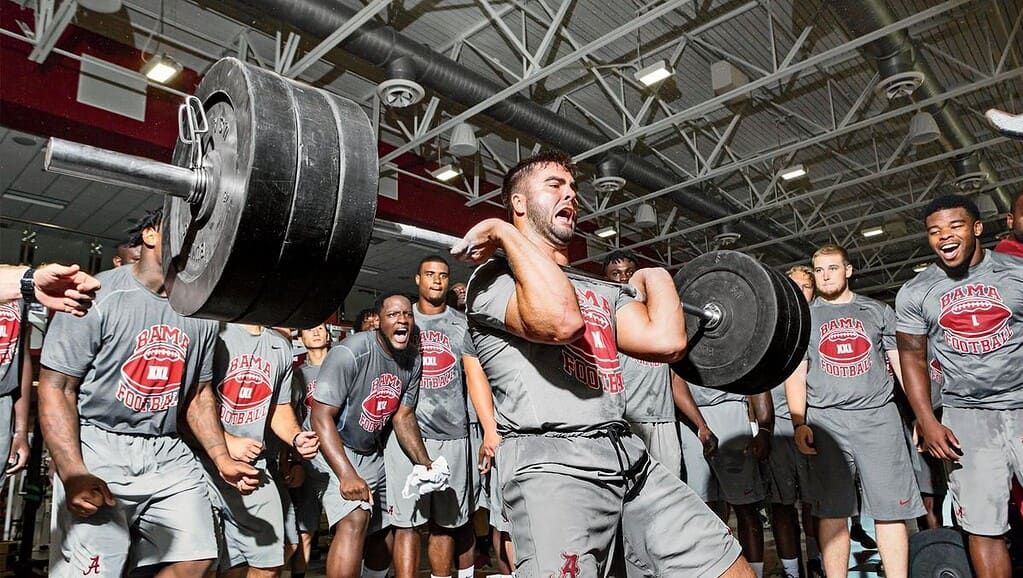[ad_1]
Greetings and welcome, it’s been a considerable duration since I authored an article (my previous one was released in July 2022), a practice I should consistently uphold as it aids me in organizing my thoughts and potentially contributes to my growth as a coach (ideally). Currently, it is 2 degrees in the garage, and I can visibly observe my breath while typing, which doesn’t create the most agile figures. To expedite the process, I have decided on compiling a list article with an intriguing title. Nonetheless, I believe this one will be both concise (p.s. it took 6 days to finalize and amounted to 2800 words) and beneficial, which I believe my audience will value. Without further delay, let’s delve into it.


1 – Cease consulting views online
During an individual’s initial phase as a lifter or while venturing into a new arena, seeking perspectives is likely beneficial for commencing. However, this timeframe is rather restricted in my view. One can easily become ensnared in over-analysis, swiftly heading towards a fruitless path. To advance as a lifter and comprehend the fundamentals, it’s crucial to first navigate the landscape and find solid ground. Once you grasp the essence of your pursuit, you must shift focus towards establishing a clear direction and purpose.
The predicament faced by most self-taught lifters, and a probable reason for their eventual abandonment or stagnation, is the perpetual reliance on maps or constant acquisition of new ones. At some juncture, it is imperative to set aside the resources and commence the journey. While there’s a possibility of straying off course initially, at least progression is underway. Engaging a coach or mentor holds substantial benefits in this regard. They are already acquainted with the optimal route, or at least possess knowledge of several pathways leading to the destination.
Once you discover an online coach/trainer whose guidance resonates with you and holds logical reasoning, consider obtaining approximately 80-90% of your training information from them for an extended period. Even better, after gaining a foundational understanding, refrain from incessantly following YouTubers, reading articles, or dedicating more time to lifting subreddits than actual training.


2 – Commence monitoring RPEs or Bar speed.
Autoregulation isn’t a new concept; I endeavored to secure funding for a PHD on the subject in 2010-2011 (my closest encounter was receiving a rejection letter from the University of Edinburgh following an interview, RIP). Mike Tuchscherer of Reactive training systems has persistently advocated for bottom-up programming and self-driven training since, as far as I can recall, around 2008-2009.
Several individuals exhibit skepticism towards RPEs due to fundamentally valid reasons, prominently the subjective nature and the assumed unreliability of lifters. However, experienced lifters routinely make numerous on-the-fly adjustments. They fine-tune their warm-ups, allocate additional time for readiness, adjust their progressions, elevate the weight when feeling robust, and reduce it when feeling suboptimal.
RPEs serve as a validated internal measure for tracking intensity levels when the lifter evaluates their own performance. It necessitates time, calibration, and honesty from the lifter’s standpoint. Understanding what truly constitutes a maximal effort holds intrinsic value. Novices and intermediate lifters often lack a true understanding of what a maximal effort entails, usually ceasing their exertions when it feels demanding, despite possessing ample reserves of energy.
An effective strategy I employ with new lifters in a program involves integrating rep-out sets accompanied by a spotter for several weeks. Alternatively, a recent addition is the implementation of call-out sets, where a lifter estimates the remaining rep count and then executes additional reps. While the call-out sets may possess an element of self-determinism that could limit applicability, the act of pushing new lifters to complete additional reps under pressure signifies a notable victory. A typical cycle I adopt includes:
5×5 @ 75% – rep out last set (achieving 10 reps)
5×4 @ 80% – rep out last set (achieving 7 reps)
5×3 @ 85% – rep out last set (achieving 5 reps)
It is customary for lifters to surpass parity by 30-50% post-week one, indicating that their reservations were due to an unfamiliarity with what 100% effort entails.
Bar speed velocity serves as a preferable metric in my opinion, as it eliminates intrinsic and extrinsic factors, providing unadulterated performance data. Moreover, it serves as an effective tool for elevating intentionality, compelling individuals to exert themselves to maneuver the weight swiftly.
Enhancing an athlete’s comprehension of performance, intention, and compensatory acceleration effort is crucial. The primary impediment lies in accessing the best or most economical methodologies for this purpose
The current cost of a reliable linear sensor on the market is still within the range of £400-450 for a good barbell.


3 – Maintain a comprehensive training log
Initially, one of the primary pieces of guidance often provided to beginners is to uphold a journal or log, which is likely one of the most valuable recommendations. Beginners are advised to keep a record or log so that they can review the previous week’s workout and attempt to surpass their previous performance.
When it comes to programming, an effective coach examines your training logs meticulously to identify trends and determine the types of training to which you respond favorably. They may prolong training blocks to assess if there is ongoing improvement. They may swiftly adjust the RPEs or percentages to gauge your response, or maintain the RPE level without pushing for weight increments to evaluate your reaction. A proficient coach continually adjusts your training regimen with subtlety while closely scrutinizing your logs.
As a self-coached lifter, you may not need to match the skills of elite powerlifting coaches in programming, but you cannot afford to neglect program design since you essentially act as your own coach. The first point initiates this process by consolidating your online information or sources to minimize interference.
By maintaining detailed logs, you will begin to recognize response patterns such as:
- I notice optimal response with increased block frequency
- I observe fatigue and difficulty progressing with volume training
- I feel most potent during low RPE workouts
You will discern trends that enable you to make informed decisions as the architect of your training. Relying on generic programs may be appropriate initially as a self-led individual, but as you gain experience and training maturity, you should adapt programs to suit your needs instead of blindly adhering to them to progress as a lifter.


4 – Record your challenging sets on video
Most powerlifters or dedicated lifters often record the majority of their sets, with many recording all of their working sets. While this is certainly a worthwhile practice (so much so that it’s included in this list), focusing on challenging sets is essential. In this context, we define challenging sets as anything exceeding 85% of the projected maximum or any set rated as RPE 8 or higher. The rationale for highlighting the challenging sets is the potential for identifying technique breakdown.
An experienced coach possessing the elusive “coach’s eye,” who has observed an extensive amount of lifting, can identify strengths and weaknesses in a lifter’s performance even during lighter intensities. For instance, with most novices, I can identify focal points primarily from the empty barbell. For intermediate lifters with a clear objective, I usually require heavier lifts to pinpoint areas of breakdown. Advanced lifters might only reveal focal points when they fail or come close to failure.
For someone less adept at identifying critical aspects when viewing videos, recording challenging sets will highlight areas requiring attention, either in skill execution or focus on auxiliary work. Additionally, if feasible, maintaining a record of challenging sets can prove significantly beneficial longitudinally. For example, if you have one set of two reps at RPE eight (1×2 @ 8) as your challenging weight set for the phase, videoing every set and comparing them week by week can provide insights into execution and bar speed.
Improvement in set execution (e.g., enhanced bar speed, greater control, or improved squat depth) can be the most substantial progress with heavier loads or during a phase. While you should note this in your log (using RPE and descriptive notes), objective measurements are invaluable as they mitigate some of the human errors inherent in managing your own training. Recording important or challenging sets on video week by week is an absolute necessity.


5 – Recognize that the plan isn’t crucial; it’s how you react to it
As you gain experience working with athletes and delve deeper into strength training, the significance of the program diminishes because ultimately, it’s not as critical as many other aspects.
- Lifter’s mindset
- Ability to focus
- Confidence
- Willingness to adapt and make effective decisions
- Training environment
- Training group
- Coach’s belief in the athlete’s ability to execute the plan
- Athlete’s trust in the plan
- Attention to the training log and the ability to put the workout into the correct context
This short list contains elements I consider more crucial for strength progress than the program the lifter follows. A program is simply a sequence of workouts and microcycles combined into a month or a few months of training. It’s undeniably a piece of the puzzle, but there are many equally, if not more, important pieces.
One critical aspect coaches and lifters should continuously seek are the program elements that enhance the lifter’s performance both subjectively and objectively. The more top-down form of periodization advocated by sport scientists and strength and conditioning coaches assumes a substantial physiological foundation for its effectiveness. However, the emerging bottom-up approaches, exemplified by Mike Tuchscherer’s strategies, provide insight into the more intricate aspects. There is a merging of science and experiential knowledge in the coaching, physiotherapy, and sports science realm. Many of the traditional “hard science” foundational principles are proving to be unstable.
Humans are incredibly complex and illogical creatures. To assume that our psychology, social context, and environment don’t have a tangible and measurable influence on our results is at best naive and at worst actively deceptive. Older styles of programs typically centered around a coach or a “method” are firmly rooted in block periodization and the insights of sports science thought leaders like Dr. Mike Stone. While these approaches have real and measurable outcomes, they treat humans as machines, biological specimens that respond predictably to inputs. That is their major deficiency.
While physiotherapy lags behind in exercise science and application compared to strength and conditioning, it excels in treating humans as what they are – humans, not machines. It incorporates psychological and social factors into its modeling through the bio-social model, which considers the patient’s mental state and social settings as real and measurable factors affecting outcomes. These are factors that aren’t even on the radar for strength and conditioning (or at least not when I was last actively engaged in reading the scientific output in the field, which was probably 3-4 years ago).
The “individual” response to exercise observed in the likes of reactive training systems’ approaches is genuine and measurable. Any coach attentive to their lifter’s training will witness this in the real world. However, I don’t believe it’s grounded in physiological response. I don’t believe the physiological response to exercise is so highly variable; if anything, it will probably be the opposite. What I believe is that bottom-up approaches allow the lifter’s preferences to surface at that time, allowing them to enter a training flow state where they feel more engaged and motivated (which is termed as momentum in common lifter speak), and this is where the underlying mechanism of cause lies.
I believe both schools of thought have merit, and the best approach to programming is to utilize both styles. There is validity to a top-down, physiological response-driven approach, but it needs to be guided by a systematic process that allows the program to revolve around the individual, not the other way around. As a self-learned lifter, you can adopt the programming work of others but use parameters such as RPE targets for weeks, progression lengths, number of working sets, and exercise count. These can be adjusted from block to block to determine your preferences or the best “response.”


6 – Workout in a gym with fellow lifters
Finally, if you are a self-guided or self-taught lifter, this point can’t be emphasized enough. I didn’t include it in my original five because for many individuals, it’s impractical to train with other lifters or have access to a gym with fellow lifters. However, if you have the capability to do so, I strongly urge you to prioritize it. There are numerous advantages to training in a group in a sport like powerlifting, particularly if you are self-coached. One of the major pitfalls of being a self-coached lifter is dwelling in the echo chamber of your own mind.
Surrounding yourself with other lifters who are pursuing their own paths or have a coach can be an excellent source of ideas. It also serves as a valuable sounding board for ideas and training concepts. Not all of your training partners will provide useful insights, but simply discussing various things out loud and debating can be invaluable for forming ideas.
Havin colleagues with a keen eye on your technique is invaluable for noticing small details that you may not pick up through video analysis. Being around lifters of a similar level or stronger can truly give a competitive edge to your training, especially if you have a competitive mindset. Additionally, assisting beginners can significantly contribute to your own progress, as you need to articulate things concerning technique and general programming if you are going to communicate them to others.
Considering lifting is, on the surface, an individual pursuit, the benefits of training in a crew or team can’t be overstated.
Hopefully, you have picked up some valuable ideas to improve as a self-coached lifter, or you may consider
Working with us in person
Working with us online
Marc
[ad_2]


